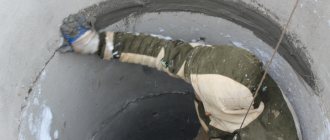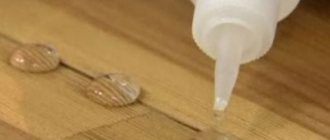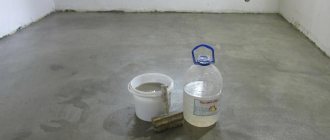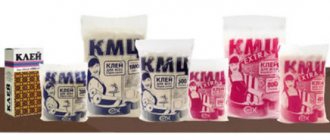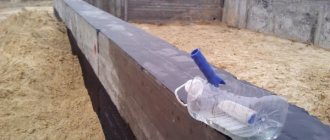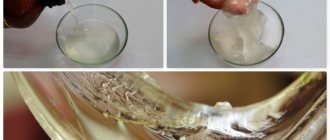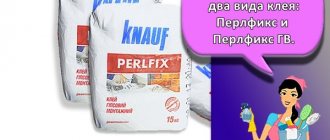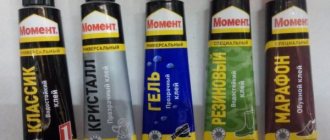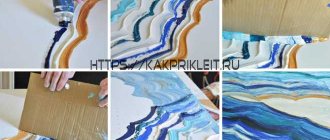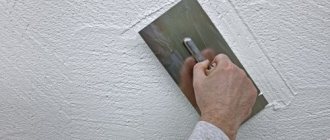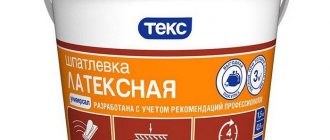The construction market is represented by a huge number of practical and effective materials that are used in construction and repair work. One of them is liquid glass, which, thanks to its unique viscous structure and high performance characteristics, is used to provide reliable waterproofing of various types of surfaces.
What is liquid glass? It is an aqueous alkaline product based on sodium and potassium silicates. There is another name for glass - silicate glue. The material manufacturing technology involves the melting of sodium and potassium salts when exposed to high temperatures.
Characteristics of liquid glass
To begin with, what is “liquid glass”? It looks like a transparent viscous liquid, which thickens in air and forms a waterproof but rather fragile film within half an hour.
Helpful information:
- Liquid glass for concrete
- Is it possible to use liquid wallpaper for the bathroom?
Like real glass, it consists of silicon compounds - silicates. For construction needs, it is especially important that they form insoluble substances with cement. These substances seal the pores in concrete, which explains the key properties of liquid glass:
- waterproof;
- frost resistance;
- bactericidal and antifungal properties;
- accelerating the setting of concrete mortar.
The latter is often overlooked by those who work with liquid glass for the first time. In an effort to make moisture- and frost-resistant concrete, beginners make fatal (for concrete) mistakes. But we'll talk about them later. Other important characteristics of liquid glass are:
- low thermal conductivity;
- fire resistance;
- antistatic effect.
All this allows liquid glass to find many applications.
Liquid glass: history and composition
Even if you are not involved in construction, you have come across liquid glass more than once in your life, because it is a well-known silicate glue. Surprisingly, this glue was invented more than 200 years ago, and to this day its composition remains unchanged.
The inventor of liquid glass is the German scientist Jan Nepomuk von Fuchs, who combined silicic acid with alkali silicates. As a result, a transparent viscous mixture was born, which, when hardened, turned into a solid transparent substance.
In the old days, glass melting furnaces were used to produce liquid glass. In them, quartz sand was melted under the influence of high temperatures, mixing it with coal and sodium sulfate or, alternatively, with soda. Today, for the industrial production of liquid glass, an autoclave is used - a specialized apparatus that combines quartz sand with alkalis under high pressure and shifts the boiling point of the mixture upward, thereby ensuring higher physical properties of the material.
Now ask yourself why, even after 200 years, liquid glass remains one of the most popular materials in the construction industry? Obviously, the whole point is in its unique properties and the versatility of its application. Let's take a closer look at them.
Types of liquid glass
It is important to pay attention to the ingredients of what you buy. All silicates are salts of silicic acid, their general chemical formula is Me2O(SiO2)n, where Me is one of the metals. It turns out that they differ only in what metal is included in them. However, there is a difference in properties.
There are three types of liquid glass: lithium, sodium or potassium silicate. Lithium silicate is rarely found on sale, so let’s take a closer look at the other two types. It is not always possible to replace one with the other, so it is better to know the characteristics of sodium and potassium glass.
Liquid sodium glass
Sodium liquid glass is a homogeneous, thick, grayish liquid. According to GOST standards, it is used in many industries:
- in the paper industry;
- in foundry production;
- in the mining and oil industry;
- to strengthen soils.
Soda glass has high fire-resistant properties. It is used to process fabrics and wood. In factory conditions, it is used to produce concrete that is resistant to high temperatures and acids.
It differs from potassium liquid glass in its higher viscosity, and it is also several times cheaper. It is used in waterproofing premises, emergency sealing of leaks, swimming pools and on ships.
Liquid potassium glass
Potassium silicate is similar to sodium silicate in consistency, but its hue is more greenish. Let's see what potassium glass is used for:
- for processing welding electrodes;
- in paint and varnish production, silicate paints are made from it;
- it is added to cement mortar for brickwork of fireplaces and stoves.
It can also be used for waterproofing, but it will cost more. But the potassium salt of silicic acid does not cause efflorescence on plastered or painted surfaces.
Compliance with Gosstandart. How much does liquid glass cost?
Sodium liquid glass is produced in accordance with GOST 13078-81. The document states that it is a viscous substance of gray or yellow color without impurities, having the following characteristics:
- the density of the material should be from 1.42 to 1.43 g/cm³;
- the content of sodium oxide concentrate is from 7.9 to 8.8%;
- the presence of calcium oxide should not exceed 0.2%;
- the part of silicon dioxide is from 21 to 24%;
- the silicate modulus value is 3%;
- the content of sulfuric anhydride should not be higher than 0.15%;
- the presence of iron and aluminum oxide is permissible - up to 0.25%.
Liquid glass is an order of magnitude cheaper than most impregnations and adhesives
One of the advantages of the material is its affordable price. It is much cheaper than other synthetic adhesives and impregnations. The cost is influenced by several factors, in particular density, modulus and the amount of liquid glass purchased. The solution is packaged in special containers that are tightly closed to prevent the product from drying out. You can buy the material at any hardware store. If you need a small amount, it is recommended to buy liquid glass in containers or on tap.
Helpful advice! Liquid glass applied as an adhesive for linoleum will prevent the formation of fungi and mold under the coating. Such protection is not provided by other adhesives, for example, Bustilat or PVA.
Popular manufacturers of liquid glass, material price
In the case when a large volume of work is planned and liquid glass is supposed to be used, the price matters, because a lot of material will be needed. In this situation, it is better to order it directly from a large manufacturer or supplier, saving on intermediaries. The most popular large enterprises include Metterra, Oxium, the factories Ivkhimprom, Kontakt, and CJSC Trading House Stekloprodukt. Small enterprises such as Alektich also specialize in the production of liquid glass. In the retail chain, this substance is presented not only in its pure form, but also as part of all sorts of impregnations and mixtures for finishing work.
Price gradation table for pure solution in accordance with GOST 13078-81:
| Material density, g/cm³ | Module | The cost of material in a volume of less than a ton, rub. | Cost of material in volumes from 1 to 10 tons, rub. | Cost of material over 10 tons, rub. |
| 1,27-1,29 | 2,9 | 10 700 | 10 200 | 10 000 |
| 1,38-1,42 | 2,9 | 11 200 | 10 600 | 10 300 |
| 1,45-1,46 | 3 | 11 500 | 11 200 | 11 000 |
| 1,47-1,48 | 3,1 | 12 000 | 11 700 | 11 500 |
Thus, the larger the volume of material purchased, the lower the price will be. High-density liquid glass has a more significant cost.
Application area
Of course, there are many more areas of application for liquid glass. It is used to make car polish. It repels dirt and water, and thanks to this composition the body looks new and shiny.
Liquid glass for concrete
Gardeners use silicate glue to treat cuttings after grafting or pruning trees. Germs or parasites can get into open “wounds,” so the sealing ability of silicates comes in handy.
Massive curtains in theaters and concert halls are covered with liquid glass. Firstly, it protects the fabric from fire, and secondly, silicate, as an antistatic agent, repels dust.
We will take a closer look at where liquid glass is used in construction and at home.
Application in construction
Liquid glass is used in a wide range of construction works:
- waterproofing of concrete walls and ceilings in buildings;
- waterproofing the foundation (if groundwater is shallow);
- waterproofing of artificial reservoirs, wells, water tanks;
- laying tiles;
- grouting joints.
But the use in construction raises the most questions - especially when it comes to waterproofing concrete. Do you need to cover a finished concrete structure with glass? Or add silicate glue directly to the solution? Opinions about where you can use silicate glue, and where you should never do it, are directly opposite.
What is the reason that the same waterproofing lasts for decades for some, while for others it crumbles into crumbs the next year? Different types of glass (or even different brands) can affect the result of the work, but usually it’s still a matter of improper use of building materials based on liquid glass.
Let's first talk about surface waterproofing - coating hardened concrete with liquid glass. This is how the screed or foundation is impregnated, or the joints between concrete rings in the well are coated.
When we talk about liquid glass, we mean a cement mortar based on it (we will return to the proportions and preparation procedure later). Builders often say this, so when reading advice on the Internet, keep in mind: pure liquid glass is not used for waterproofing. The film will simply peel off when moisture gets on it.
The main thing to consider is that calcium silicates, which are formed during the reaction of cement with liquid glass, penetrate several millimeters into the concrete. That is, strong impacts that damage the surface will also damage the waterproofing layer. Often glass alone is not enough; several methods must be combined.
Volumetric waterproofing - mixing concrete with liquid glass. In fact, silicate is not a water repellent, plasticizer or other additive to concrete. The main problem is that it accelerates hardening. This is not as good as it seems - it takes time for concrete to mature and gain strength. And then, the solution then needs to be poured very quickly. This can be done somewhere on a construction site, with specialized equipment, but at home?
By the way, thanks to its rapid hardening, a mixture of concrete and liquid glass has long been used in ship accidents. This is nothing more than an effective, but short-lived “patch” - until such time as it is possible to carry out more thorough repairs.
Small portions of liquid glass will not affect the setting time, but there will be no water-repellent effect. At your own peril and risk, you can try to add silicate glue no more than 3% of the cement content in the solution. But why do you need liquid glass if you can buy a special hydrophobic additive?
To summarize: in order to protect concrete from moisture and maintain its strength, impregnation with cement mortar based on liquid glass is a more proven method, therefore all further instructions for use will be given specifically for surface waterproofing.
Use in everyday life
Liquid glass is used to seal joints during plumbing work: they are applied to the parts at the point of contact, connect them and hold them together for several minutes until they harden.
Silicate is used to cover the joints of water and sewer pipes, but not gas pipes.
Silicate glue is suitable for laying linoleum. PVA and Bustilat also glue linoleum sheets well, but liquid glass also prevents the growth of bacteria and fungi underneath it.
Liquid glass for concrete
It can be used to glue things made of ceramics, wood, plywood, cardboard, rubber and leather, and to place elements of mosaics and stained glass on it. For those who like to create home decor, liquid glass is a real find.
However, you should not glue dishes intended for food with silicate glue.
Silicate glue is not popular among today's schoolchildren, when there are more convenient glue sticks for office work and paper applications. But in the modern generation, it unexpectedly found a new life: it is used to make fashionable slime toys, or, as they say now, “slimes.” Look at this site, just for fun.
Liquid glass is used for many things and around the house. It perfectly cleans old dirt, grease, and scale. Mix water with silicate glue approximately 25:1, immerse the dishes in it, and let it boil. For a burnt frying pan, the boiling time is two hours, for glass and ceramics – ten minutes. After this, the deposits will fall off and can be easily cleaned off with a sponge. So now, if you have some glass left over, it won't go to waste.
Types of material
The composition of the substance determines the main parameters of individual types of liquid glass:
Sodium, which in its structure has a main component - sodium silicate. Due to its excellent adhesive properties, the material is used when working with different types of materials. It is also applicable regardless of the climatic zone of the facility.
Soda glass is used to reinforce foundations, for the production of household chemical compositions, glass and porcelain products, and for antiseptic surface treatment.
Potassium - its basis is potassium nitrate. Unlike the previous type, no glare occurs when using it. Therefore, it is widely used for exterior finishing work and in the production of paints and varnishes.
Pros and cons of liquid glass
Liquid glass is valued for:
- Covering power - seals the smallest cracks.
- Low consumption and low cost (when compared with other sealants).
- Long service life - five years.
- It can be used in high humidity conditions.
- Non-toxic - does not emit hazardous compounds into the air, chemically neutral.
However, silicate glue also has some disadvantages:
- Not suitable for application on brick surfaces.
- The film is quite fragile, so it is necessary to use other waterproofing methods.
- Liquid glass sets in the shortest possible time, so in order to apply the solution in time, experience and skill are required.
Scope of use
The excellent technical characteristics of the material determine the widespread use of liquid glass in various areas of everyday life and in the industrial environment:
- for waterproofing walls, floor bases, foundation structures and ceilings, as well as various containers - swimming pools, fountains, wells;
- for joint treatment with cement mortar of metal surfaces in order to protect against corrosive destruction;
- for fireproof protection of stoves and chimneys, as well as wood, including during its antiseptic treatment;
- when gluing products made of cardboard, wood, porcelain, etc.;
- for the purpose of preparing paintwork materials for façade painting.
However, it is impossible to use the material for waterproofing a brick surface - the structure will begin to collapse. If you are planning to carry out waterproofing work, you need to take into account that the emerging film is very thin. This can be clearly seen in the photo of liquid glass.
Therefore, reliable protection is provided only when used in combination with other materials. Glass dries quickly, which means you need to work with it as quickly as possible.
How to prepare a solution with liquid glass
Depending on what liquid glass is needed for, compositions are prepared that differ in the ratio of components.
To prepare a concrete hardening agent, you need to take:
- 400 g of liquid glass;
- 1 liter of water.
Concrete is covered with this composition in 2-3 layers. Each one must dry before applying the next one.
The antiseptic also contains water and silicate glue - but in a 1:1 ratio. They can process not only concrete, but also other materials.
A primer is also prepared from liquid glass. For stronger adhesion of the waterproofing to the base, it is first primed, and only then the base composition is applied. Here there should be equal amounts of glass and cement, and enough water so that the solution is fluid.
The mixture for waterproofing is prepared in the same way, from Portland cement and liquid glass, but sifted sand is also added. All components are taken in equal parts.
For fireproof mortar for laying furnaces, you need: cement, washed sand and liquid glass - in a ratio of 1:3:1. The glue dissolves in water and adheres to the dry components.
Which is better – liquid glass or ceramics?
It is difficult to say unequivocally which type of glass-like coating is better. While it outperforms ceramics in some respects, liquid glass is inferior in others. By comparing these two materials, the following results can be obtained:
- The service life of both materials is practically the same. The service life, depending on the scope of application, is about 5 years. The car coating will have to be renewed every year, regardless of whether it is made on a ceramic or silicate basis.
- In terms of the degree of protection of surfaces from mechanical damage, ceramics are more reliable than liquid glass. However, the strength of the silicate adhesive film is also sufficient to solve most problems.
- In terms of decorative qualities, the materials are also quite similar. Both types of coating provide a shine reminiscent of glass. At the same time, ceramics are somewhat denser and reflect light flux less well.
- In terms of price, liquid glass beats ceramics.
Thus, it turns out that the choice of material depends on the available budget, assigned tasks and personal preferences.
Instructions for use of liquid glass
You will need the following tools:
- containers of different sizes (for convenience);
- drill mixer;
- spatulas, brushes, rollers.
Before working with liquid glass, wear gloves. It is a strong alkali and can damage your skin.
So, how to use liquid glass as waterproofing:
- Prepare the base: remove the old coating, any loose pieces, construction debris, grease and dust. Otherwise, the silicate glue will fall off.
- Prime the surface with the first layer.
- Leave to dry for 30-60 minutes.
- Apply a second coat of primer and wait for it to dry again.
- At this time, you can begin to prepare a solution of liquid glass. Just not too much in advance - the composition hardens in 20-25 minutes. Prepare as much as you will use at one time.
- Now you can cover the prepared base. Work quickly before the silicate glue hardens. Apply it using a spatula in an even layer.
Liquid glass for concrete
When everything is ready, you need to leave the liquid glass until it crystallizes completely. Sometimes it takes a day, sometimes several days. The higher the humidity in the room and the thicker the layer of silicate glue, the longer it takes to dry. It also depends on the glass itself. Different brands and batches may have slightly different composition.
Features of application: how to apply liquid glass
Before applying the product, the surface must be thoroughly cleaned of any contaminants that may reduce absorbency. Surfaces treated with silicate solution must dry for at least 24 hours. According to the instructions for use, liquid glass is applied in several layers, with sufficient time allowed for each layer to dry. The surface is treated with a product similar to thick paint - using a brush or roller. If it is necessary to create a protective coating, the material is applied with a plaster spatula.
All work must be performed sequentially, in accordance with the instructions. You can use liquid glass yourself, saving on fees for the services of specialists. First, the surface must be thoroughly cleaned of stains, debris, dirt, and old coating. Next, apply the first layer of the product with a roller. After it has dried, the surface is covered with a second layer.
Liquid glass must be added to the concrete solution immediately before work
If it is intended to use a concrete solution with the addition of sodium silicate, then it is prepared immediately before use, since the mixture hardens quickly. You need to apply it within 20 minutes. Strict adherence to proportions is important. The slightest mistake can cause the surface to crack and collapse.
While working, you must wear special clothing and use personal protective equipment. Upon completion of the process, you must thoroughly wash your hands and tools before the remaining material dries.
Is it possible to make liquid glass with your own hands?
You can make silicate glue at home in two ways.
The easiest way is to crush the silica gel and mix it with water. The composition will be the same as what is sold in the store.
A longer method: mix pure quartz sand and soda at a ratio of 1:4 and heat until melting. And there is also some kind of silicate glue - not in composition, but in properties. It is made from paraffin (a regular candle will do) and White Spirit solvent.
Maybe one of these methods will come in handy one day. But in general, buying ready-made liquid glass is more profitable than making it yourself.
Advantages of the composition
Waterproofing, fireproof and other characteristics of liquid glass determine the important advantages of the material:
- high penetrating ability and excellent adhesion;
- fire resistance with a low level of thermal conductivity, which helps when carrying out thermal insulation work;
- elasticity, so that shrinkage of the building does not impair waterproofing;
- application at high humidity levels;
- environmental friendliness of the mixture and its safety for humans.
These parameters are combined with relatively low cost and accessibility for various categories of citizens. The construction cost does not increase significantly.
Subtleties of using the component
It must be remembered that liquid glass sets very quickly when an adhesive mixture is made from it. Experienced craftsmen advise doing the necessary fitting and be sure to adjust all the constituent elements of the structure before gluing. This is necessary to ensure that the commit is completed without any delay.
Of particular importance is the use of silicate adhesive mixture for waterproofing. Liquid glass forms a thin film, which can be fragile. For this reason, it will be rational to use several separate types of hydrophobic agents.
Experienced specialists do not recommend using silicate glue on brick walls. The structural features of brick make this building material insufficiently resistant to the components that make up liquid glass.
When treating a surface to ensure its effective waterproofing, a very strict sequence of actions must be followed:
- It is first necessary to clean the working surface from accumulated dust and dirt;
- The primer should be applied in several layers and dried first;
- The protective mixture is made of cement, sand and liquid glass;
- The prepared solution must be distributed with a spatula over the treated area.
So that the entire solution can be used before it hardens, it is advisable to add the liquid glass component only in small portions.
Application in construction
In accordance with the basic properties of liquid glass, its range of applications in construction is quite wide.
Important!
The key to efficiency and economic efficiency is the correct proportions.
Waterproofing additive for concrete
So, for waterproofing foundations and basement walls, it is enough to use a solution where the glass/water ratio is 1:2. In this case, the optimal number of coating layers is at least two.
The most popular is the use of liquid glass to improve the quality of working solutions. So for brickwork, one liter per hundred liters of mortar is added to the mortar.
Attention!
Even the minimal presence of silicates in cement mortar significantly accelerates its hardening time! In this regard, even minimal downtime in masonry is fraught with the loss of unused binder and fastening substance.
For waterproofing pool bowls, the optimal consumption is 0.5 liters per cubic meter of solution. The number of insulation layers is at least two.
When preparing solutions for grouting masonry joints or spaces between tiles, the guaranteed concentration is considered to be 1 part liquid glass to three parts grout.
Professional tilers readily use sodium silicates in the formulation of basic solutions. Linoleum will lie flat and will never “wave” if the floor is first treated with a 10% solution of liquid glass.
Greater efficiency is demonstrated by concretes operating in a humid environment (piles, bridge supports, piers, artificial reservoirs) that contain soda glass. When constructing buildings where groundwater comes close to the surface, a liquid glass component must be present in the concrete formulation for foundations, basement walls and utility gutters.
Application in various fields
Note: There are concrete recipes where sodium glass is used instead of water. The result is a solution with increased adhesion and a minimum formation (hardening) period.
Soda glass demonstrates good efficiency in the construction of screeds and self-leveling floors. Abundant coating of surfaces previously cleaned of dust allows the aqueous silicate solution to penetrate 3-4 mm inside, which strengthens the surface layer and eliminates any problems later.
Do-it-yourself waterproofing with liquid glass
It should be noted that from the advantages of using liquid glass there is also one drawback. It lies in the impossibility of subsequent painting of surfaces where a sodium or potassium silicate compound was originally used in the formulation.
Material characteristics
The fresh, uncured mass is similar to viscous jelly, but after it hardens, a waterproof substance is formed that perfectly performs its functions at extremely high temperatures.
The key characteristics of liquid glass include:
- Waterproof. This determined the use of liquid glass as one of the main waterproofing materials;
- Sterility. Most microorganisms cannot develop and live on the treated surface;
- No electrostatic effect. Thanks to this, the composition can be safely used in places with a high content of flammable elements;
- Fire resistance. The composition is non-flammable and protects the treated surface from exposure to fire and acid-containing elements.;
- Strength. After hardening, it forms a reliable protective film that can protect the wall from mechanical damage.
Advantages over standard waterproofing compounds:
- Filling the smallest cracks and protecting all types of surfaces from wood to metal;
- The protective film has increased rigidity;
- Less amount of material required, and affordable price;
- Durability;
- Can work in high humidity conditions.
Waterproofing Instructions
Let's get acquainted with the recommendations for applying liquid glass in order to ensure maximum waterproofing. It is imperative to follow the following sequence of actions:
- It is necessary to clean the surface to be treated from dust and all kinds of contaminants;
- The first layer of primer is applied to the surface using a brush or a regular roller;
- After this, you need to wait at least half an hour and then apply an additional layer. It is imperative to ensure that there are no gaps left on the surface being processed;
- It is necessary to prepare a protective composition from cement, sand, as well as high-quality liquid glass;
- You need to mix the prepared solution very quickly, and then carefully apply it to the surface without delay using a spatula;
- It is imperative to use special protective clothing during such construction work to avoid contact of aggressive chemicals with the skin or mucous membranes.
It must be remembered that the desired amount of the prepared solution must be applied to the surface within 15-20 minutes.
Features of use
In its pure form, this material is rarely used. Its main purpose is the preparation of building mixtures:
- primers;
- waterproofing mixture;
- fireproof and antiseptic solution;
- strengthening mixture.
If you plan to use liquid glass for the floor, then it is advisable to follow the following sequence of actions:
Waterproofing with liquid glass
Waterproofing solutions using ZhS allow you to treat any structures, including concrete and wood, in established areas with humidity exceeding the norm.
Foundation
To protect the foundation from destruction in a humid environment, it is necessary to apply liquid glass for concrete. The instructions for use indicate that for maximum protection this operation should be performed twice. After application, the layer must dry completely, then apply the next one. After the concrete base is impregnated with glass, the insulation is reinforced with other technical materials.
To eliminate cracks and mask the joining seams, prepare a repair composition in the following ratio: cement - 1 kg, water 750 ml, ZhS - 50 grams. To ensure better protection of the concrete base, it is recommended to use ZhS in the form of an additive in a volume of 5% of the total mass of the mixture.
swimming pool
To eliminate leaks in the bathtub of a structure, it is necessary to treat the surface of the concrete. The solution is evenly applied to the walls and floor of the structure. After one layer has dried, apply the next one. To reliably protect the structure, it is recommended to impregnate it three times.
From exposure to groundwater
Special concrete, which contains LC, can limit the flow of groundwater.
Basement
This is an important structure in the house and isolating it from leaks is the main condition for maintaining a favorable climate in the apartment and in the interior. Typically, owners are faced with the problem of cracks and poor waterproofing of joints. To get rid of the problem you will need:
- Clean cracks and seams from foreign objects and dust;
- Prepare a repair mixture in the following ratio: cement – 20 parts, liquid glass – 1 part. Maximum plasticity of the mixture should be achieved, for which its consistency is controlled by the volume of water;
- Cracks are sealed with repair mortar;
- Level the repair site by plastering it with the same mixture;
- The repair area is coated with water using a brush;
- After 24 hours, a layer of GS is applied.
When performing waterproofing work, it is necessary to remember the chemical reactions that occur with mixtures in which liquid iron is present. Due to the rapid hardening of the solution, in order to save material, it is recommended to prepare small volumes for work.
Preparation of the solution
Let's consider the basic sequence of actions necessary to prepare a solution for the foundation:
- Add one glass of liquid glass to a container with clean water, and then mix thoroughly using a mixer;
- After this, the liquid is poured into another container, where the remaining components of this dry mixture are gradually added;
- Using a mixer, the resulting solution is whipped until a homogeneous composition is obtained;
- The prepared solution with liquid glass is added to the formwork.
It is better not to use any technical water for kneading. The quality of the concrete mixture can deteriorate significantly if another mixture is added to it.
To treat the antiseptic you need to use a 1:1 ratio. The resulting solution is applied to a wooden or stone surface using varnish or a brush.
The refractory mixture for equipping furnace structures can be prepared according to a special recipe:
- Cement 1 lobe;
- White sand 3 shares;
- Special silicate glue or liquid glass 20% of the total mass.
First, the sand-cement mixture is mixed with the addition of a small volume of water, and only then liquid glass is added to the components prepared in advance.
